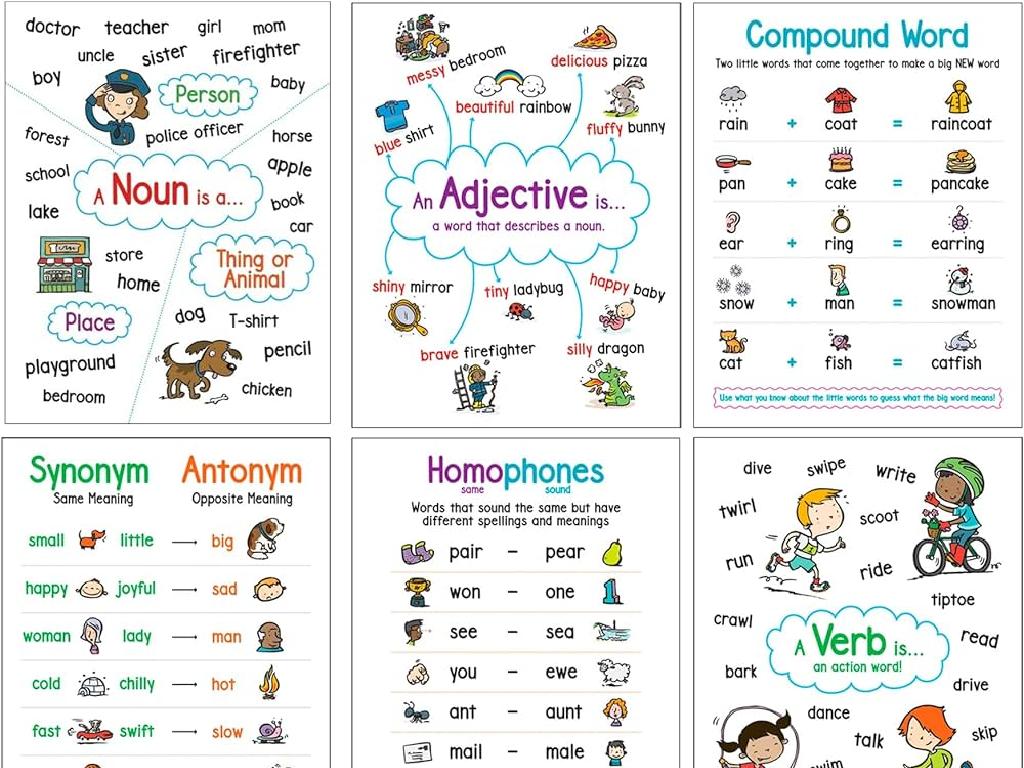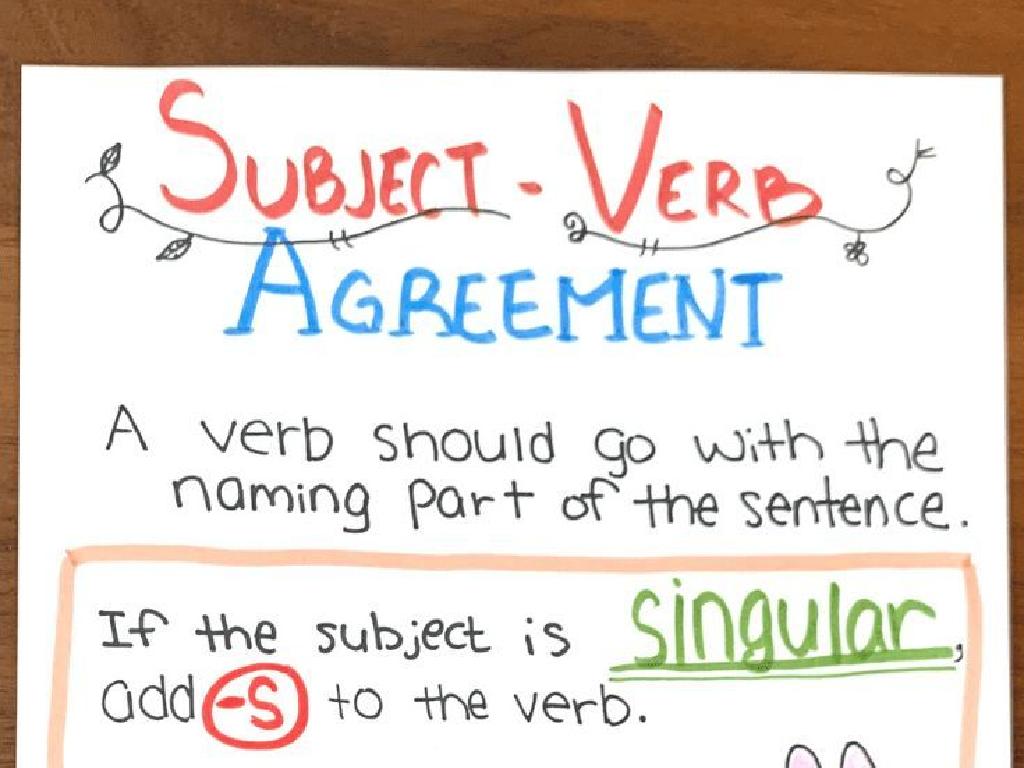Is It A Direct Object Or An Indirect Object?
Subject: Language arts
Grade: Seventh grade
Topic: Direct And Indirect Objects
Please LOG IN to download the presentation. Access is available to registered users only.
View More Content
Understanding Direct and Indirect Objects
– Sentence structure basics
– Objects in sentences
– Objects receive the action of the verb
– Identifying direct objects
– Direct objects answer ‘what’ or ‘whom’ after the verb
– Recognizing indirect objects
– Indirect objects answer ‘to whom’, ‘for whom’, ‘to what’, or ‘for what’ after the action
|
This slide introduces the concept of direct and indirect objects as part of sentence structure in Language Arts. Begin by explaining the basic components of a sentence, including the subject, verb, and objects. Emphasize that objects are essential as they receive the action of the verb. Direct objects can be identified by asking ‘what’ or ‘whom’ after the verb to find what is receiving the action directly. Indirect objects are found by determining to whom or for whom the action is being done. Provide examples for clarity, such as ‘She gave her friend a gift.’ (‘friend’ is the indirect object receiving the gift, the direct object). Encourage students to practice by identifying the objects in sentences from their reading material.
Understanding Objects in Grammar
– Define grammatical object
– An object in grammar is a word that receives the action of a verb.
– Objects’ role in sentences
– It’s what or whom the action is done to.
– Examples of objects
– ‘She threw the BALL.’ (BALL is the object receiving the action of being thrown)
– Differentiating objects
– Direct objects answer ‘what’ or ‘whom’ directly after the verb, while indirect objects answer ‘to whom’ or ‘for whom’.
|
This slide introduces the concept of objects in grammar, focusing on their role within sentences. An object is the recipient of the action performed by the subject via the verb. It’s crucial for students to recognize objects to understand sentence structure better. Provide clear examples where the object is receiving the action of the verb. Encourage students to identify objects in sentences by asking ‘what’ or ‘whom’ is receiving the action. Highlight the difference between direct and indirect objects, as this will be the foundation for understanding more complex sentence constructions. Use additional examples to illustrate the difference between direct and indirect objects.
Understanding Direct Objects
– Direct objects receive action
– The receiver of the verb’s action, e.g., ‘She kicked the ball.’
– How to find: ask ‘What?’ or ‘Whom?’
– After the verb, ask ‘What is kicked?’ Answer: ‘the ball’.
– Practice with example sentences
– ‘He read the book.’ Ask ‘What did he read?’ Answer: ‘the book’.
|
This slide introduces the concept of direct objects in sentences, which are the nouns or pronouns receiving the action of the verb directly. To identify a direct object, students should ask ‘What?’ or ‘Whom?’ in relation to the verb. Provide practice sentences for students to apply this technique, such as ‘She kicked the ball.’ where ‘ball’ is the direct object. Encourage students to create their own sentences and identify the direct objects. This exercise will help solidify their understanding of the grammatical concept and improve their ability to analyze sentence structure.
Understanding Indirect Objects
– Indirect objects receive action
– An indirect object benefits from the action, e.g., ‘She gave Jake a gift.’ (Jake is the indirect object.)
– How to find an indirect object
– Ask ‘To whom?’, ‘For whom?’, ‘To what?’, or ‘For what?’ after the direct object to find the indirect object.
– Practice with example sentences
– ‘The teacher read the students a story.’ Who is the story being read to? Students – the indirect object.
– Indirect vs. Direct Objects
– Direct objects are acted upon directly, while indirect objects are recipients of the direct object.
|
This slide introduces the concept of indirect objects in sentences. It’s crucial to explain that while direct objects receive the action of the verb directly, indirect objects are the recipients of this action. Use clear examples to illustrate the difference. During practice, provide sentences and guide students to ask the key questions to identify the indirect objects. Encourage them to differentiate between direct and indirect objects by analyzing the role each plays in a sentence. This understanding is fundamental in mastering sentence structure and grammar in Language Arts.
Direct vs. Indirect Objects
– Compare direct & indirect objects
– Direct objects receive the action, while indirect objects are who/for whom it’s done.
– Understand their roles in sentences
– Direct objects answer ‘what?’ and indirect objects answer ‘to/for whom?’ after the verb.
– Examine examples with both objects
– ‘She gave her friend a gift.’ Gift=direct object, friend=indirect object.
– Practice identifying each object
– We’ll do exercises to spot direct and indirect objects in various sentences.
|
This slide aims to clarify the difference between direct and indirect objects in sentences. Direct objects are the recipients of the action, answering the question ‘what?’ post-verb. Indirect objects tell us to whom or for whom the action is done, usually placed before the direct object and answering ‘to whom?’ or ‘for whom?’. Use clear examples to illustrate these points, ensuring students can identify each type of object. Provide practice sentences for students to apply their understanding, reinforcing the lesson with interactive activities.
Let’s Practice: Direct & Indirect Objects
– Interactive sentence building
– Identify direct & indirect objects
– Find the object receiving the action and the object receiving the benefit
– Group activity: craft sentences
– Use creativity to make sentences with both objects
– Share and discuss findings
– Explain your choices to the class
|
This slide is for an interactive class activity focused on understanding direct and indirect objects in sentences. Begin with a collaborative sentence construction exercise to apply the concepts. Then, have students identify the direct objects (the receiver of the action) and indirect objects (the receiver of the direct object’s action) in given sentences. Split the class into small groups and let them create their own sentences that include both a direct and an indirect object. After the activity, encourage groups to share their sentences with the class and discuss the rationale behind their choices. This will help reinforce their understanding of the grammatical concepts and improve their ability to analyze sentence structure.
Class Activity: Object Hunt
– Pair up and pick a favorite book
– Find sentences with objects
– Look for action verbs to find the object
– Highlight direct and indirect objects
– Direct objects receive the action, indirect objects are who/what it’s for
– Share discoveries with the class
|
This interactive activity is designed to help students identify and differentiate between direct and indirect objects in sentences. Instruct students to work in pairs to encourage collaboration. They should choose a book they enjoy and search for sentences that contain objects. Guide them to highlight the direct objects, which receive the action of the verb, and the indirect objects, which are the recipients of the direct objects. After the hunt, each pair will present their findings, explaining why they labeled the objects as they did. This will reinforce their understanding and provide an opportunity for peer learning. Possible variations of the activity could include using different books, creating a competition, or having students write their own sentences with direct and indirect objects.
Wrapping Up: Direct & Indirect Objects
– Recap: Direct vs. Indirect Objects
– Direct objects receive the action, while indirect objects are who/for whom the action is done.
– Why sentence structure matters
– Understanding how sentences are built helps with writing and comprehension.
– Homework: Craft 10 sentences
– Include both direct and indirect objects in your sentences.
– Share your sentences next class
|
As we conclude today’s lesson, remind students of the key differences between direct and indirect objects. Emphasize the importance of sentence structure in understanding and constructing meaningful sentences. For homework, students should write 10 original sentences that include both direct and indirect objects to reinforce their learning. Encourage creativity and variety in their sentences. In the next class, ask volunteers to share their sentences and discuss the role of each object in the sentence. This will help solidify their understanding and prepare them for more advanced grammar concepts.





